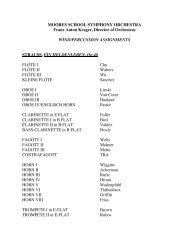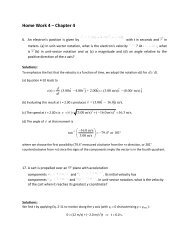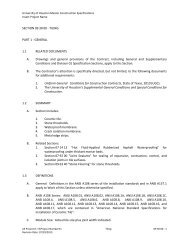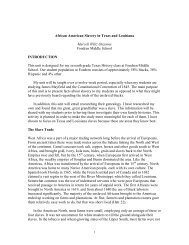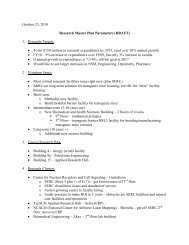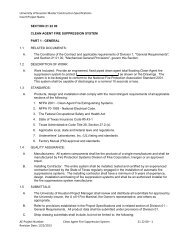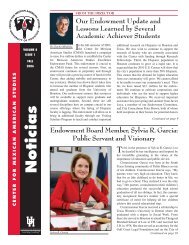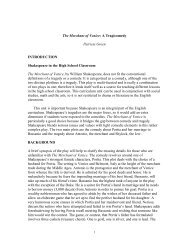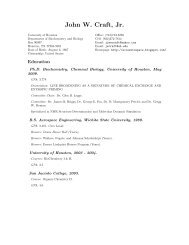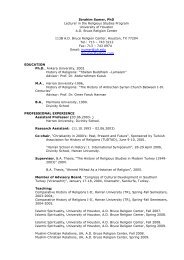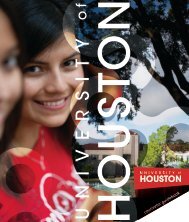Going Green: Biomimicry Francisca Eunice Gomez Rebullida ...
Going Green: Biomimicry Francisca Eunice Gomez Rebullida ...
Going Green: Biomimicry Francisca Eunice Gomez Rebullida ...
Create successful ePaper yourself
Turn your PDF publications into a flip-book with our unique Google optimized e-Paper software.
Assessment<br />
Each student will create a diorama of their own forest. Use the students’ rubric and explain to the<br />
students that will be the grading system. Create a diorama. A diorama is a mini forest in a shoe<br />
box. Students will use their own art ideas like making tree models out of dried stems/branches, et<br />
cetera. Another form of assessment is the pyramid foldable. Students will compare and contrast<br />
different forests. The diorama or the foldable must have an explanation or an informational sheet<br />
written or typed up. Challenge the students to role-play trees in the forest telling others like<br />
humans and animals to save the trees because people and animals have destroyed their ecosystem<br />
and trees need help to sustain the Earth’s forests.<br />
ANNOTATED BIBLIOGRAPHY<br />
Works Cited<br />
Allaby, Michael. The Environment. .Milwaukee: Gareth Stevens Publishing. A World Almanac Education<br />
Company, 2000.<br />
The book describes the importance of a healthy environment and its effect to Earth’s survival.<br />
Benyus, Janine. <strong>Biomimicry</strong>: Innovation Inspired by Nature. New York: Harper Collins Publishers, 1988.<br />
This is a great book that explains the new science of biomimicry.<br />
Carson, Rachel. The Silent Spring. Boston, Houghton Mifflin, 1962.<br />
This book was written to describe the hazardous effects of DDT to human health and the environment.<br />
Carter, J. Stein. “Photosynthesis.” 2 Nov 2004. .<br />
This website provides the process of photosynthesis information.<br />
“Chinaberry, Chinatree.” Herbvideos.com. .<br />
This website provides information on chinaberries.<br />
Cole, Joanna. The Magic School Bus In The Rain Forest. New York, Scholastic Inc.,1998.<br />
Ms. Frizzle, the science teacher takes her students in her magic bus to the Amazon Forest.<br />
Cross, Jacqueline. “Ten Texas Native and Wild Plants” 28 Feb 2009. Dave’s Garden.<br />
.<br />
This website describes Texas plants that are medicinal.<br />
Cummings, Jim. ESL and Second Language Learning Web. 2003.<br />
.<br />
This website describes the BICS and CALP distinction by Jim Cummins.<br />
“Cypress.” Herbvideos.com. < http://www.herbvideos.com/cypress.htm>.<br />
“Juniper.” Herbvideos.com. .<br />
This website provides information on juniper trees.<br />
Kalman, Bobbie. Photosynthesis: Changing Sunlight into Food. New York: Crabtree Publishing Company,<br />
2005. This non-fiction science book describes photosynthesis.<br />
Krashen, Stephen. “Why Bilingual Education? ERIC Digest. .<br />
This website provides information about the importance of bilingual education by Stephen Krashen.<br />
Reed-Jones, Carol. The Tree in the Ancient Forest. Nevada, CA: Dawn Publications, 1995.<br />
This book will captivate students’ interest about animals depending on trees and trees depending on<br />
animals for survival.<br />
Rutten, Joshua. Forests..The Child’s World Incorporation, 1999.<br />
This book explains and shows beautiful illustrations of different forests.<br />
Taylor, Rives. Seminar Leader. “<strong>Going</strong> <strong>Green</strong>.” Houston Teacher’s Institute Seminar. Spring 2009.<br />
<strong>Francisca</strong> <strong>Eunice</strong> <strong>Gomez</strong> <strong>Rebullida</strong> 81



